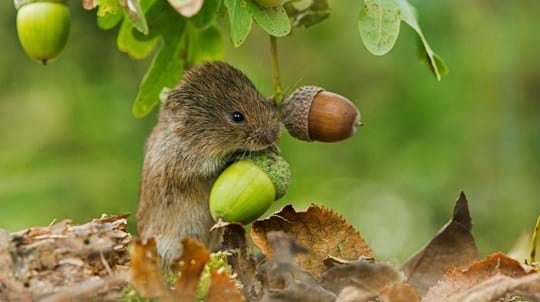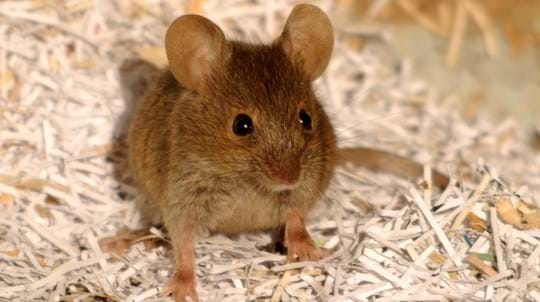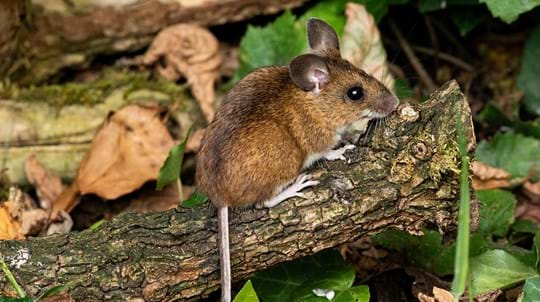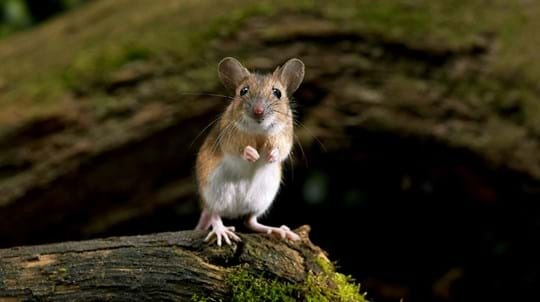
Credit: John Gooday / Alamy Stock Photo
What do bank voles eat?
Bank voles have a varied diet of vegetation, roots, fungi and a variety of fruits and nuts – blackberries are a particular favourite – as well as occasionally hunting for small insects.
Stout but speedy, the bank vole skitters around woodland and dense vegetation looking for blackberries, nuts and small insects. It uses its large ears to listen out for its many predators, such as the fox and kestrel.
Common name: bank vole
Scientific name: Myodes glareolus
Family: Cricetidae
Habitat: woodland, farmland, grassland urban areas
Diet: fruit, nuts and small insects
Predators: raptors and larger mammals
Origin: native
Bank voles are small chestnut-brown rodents with a cream-coloured underbelly and a short hairy tail.
Like all voles, it has small eyes, a short tail and a rounded snout. Bank voles have large ears (but not as large as mice) which distinguish them from other UK vole species.
Not to be confused with: the field vole. Field voles have a shorter tail (around 30% the length of its body, compared to 50% for the bank vole). Also, don’t confuse with mice, which are not as stoutly built as voles and have very long, hairless tails.

Credit: John Gooday / Alamy Stock Photo
Bank voles have a varied diet of vegetation, roots, fungi and a variety of fruits and nuts – blackberries are a particular favourite – as well as occasionally hunting for small insects.

Credit: Juniors Bildarchiv Gmbh / Alamy Stock Photo
Bank voles usually breed in shallow burrows. They produce three to four litters of between three and five young per year. Females tend to favour dominant males. Both males and females can be aggressive to litters that aren’t their own, with some females attacking litters in overlapping territories.
Voles are born hairless and blind and are weaned after about 25 days. Females reach sexual maturity after six weeks and males after eight. Bank voles can live for around two years, but few reach such an age, with many falling victim to predators.
If you listen you may be able to hear bank voles.
They can make a low growling noise as well as the squeaks you might expect from a rodent.
Bank voles are common and widespread across the UK. They don’t hibernate so you can spot them all year round. Their burrows are often in grassy areas buried shallowly underground but can be above ground provided there is thick cover.
Look out for them on woodland edges and hedgerows; they’re very fast though so you’ll need a keen eye!
They may be hard to spot. Bank voles avoid being caught by their many predators by sticking to dense vegetation and even using underground tunnels for safety.
Bank voles are ever wary of danger, so most sightings are just a fleeting glimpse. If you hear a rustling in the undergrowth, stay very still and quiet and you might catch a glimpse of a foraging vole. Some bank voles become more confident in urban areas and you might even spot one near your bird feeders looking for an easy meal!

Credit: Adrian Coleman / WTML
The bank vole population is thought to be stable with no severe threats. However, the species will be affected by damage and destruction to hedgerows and woodland, which represent important habitat. We are restoring, planting and protecting woods and trees to help maintain the biodiversity so vital to all of our native wildlife.

Trees woods and wildlife
Cute and in huge numbers, but rarely seen. The grass-tunnelling field vole is our most abundant mammal. Find out how they breed, what they eat and where to spot them.

Blog
Helen Keating • 28 Mar 2022

Trees woods and wildlife
Despite being one of our most common woodland mammals, the small, sweet and secretive wood mouse is hard to spot. Learn how to identify it, spotting tips, how it breeds and more facts.

Trees woods and wildlife
Agile, alert and rarely seen. The yellow-necked mouse is only found in the mature and ancient woodlands of southern Britain.Learn about what they eat, how they breed and lots more.